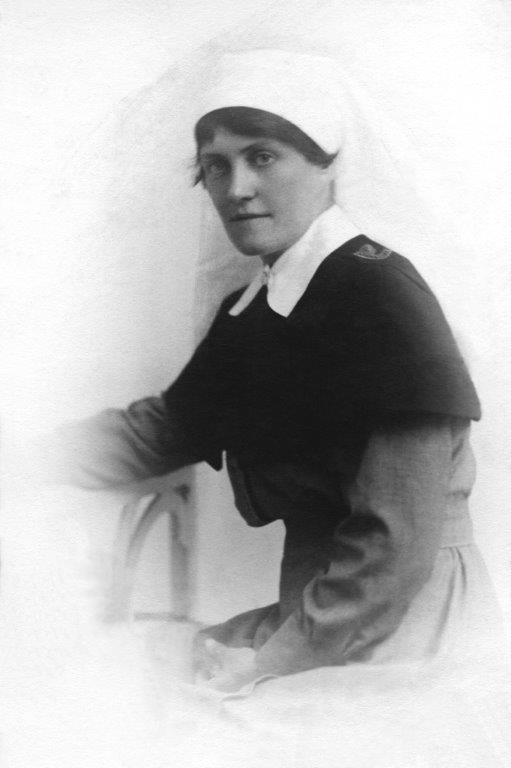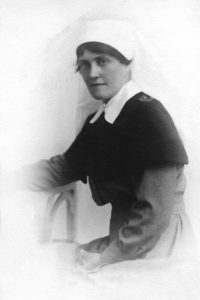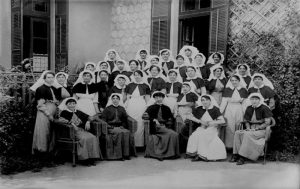Florence Emily Isabel McDonald was born in Crookwell in 1878 and was one of eight children of George and Clara McDonald.
Florence completed her nursing training at Goulburn District Hospital, where, in 1909, she was awarded First Prize for Surgical Nursing. Her prize was the book: The Poetical Works of Sir Walter Scott and was inscribed: “First Prize for Surgical Nursing Awarded to Nurse Florence McDonald by G.A. Buchannan MB : ChM. Goulburn Hospital December 12th 1909“.
Nurse McDonald volunteered to serve in World War I, joining the Australian Army Nursing (AANS) on 30 July 1915. She left Australia the following day on the ship Orestes. No doubt her exceptional surgical skills stood her in good stead for her impending war service.
Florence served overseas for almost four years. During 1915 and early 1916 she served in various hospitals in Greece and Egypt, as well as on several hospital ships.
In August 1916 she was transferred to the United Kingdom where she nursed wounded soldiers at Dartford, Birmingham and Brighton hospitals. In May 1917 she was transferred to the Western Front in France, where she served in the 25th General Hospital at Boulogne.
On 31 December 1917 Nurse McDonald was admitted to the hospital at Rouen suffering from debility. She was granted three weeks’ furlough following her recovery, rejoining her unit in February 1918. On 1 October 1918 she was promoted to Sister.
On 28 March 1919 Sister McDonald boarded the ship City of Poonah at Southampton for her return to Australia, arriving on 16 May 1919. She was awarded the 1914/15 Star, the British War Medal and the Victory Medal for her war service.
Florence went back to work following her return home. At Orange Base Hospital she nursed a patient named George McDonald; they later married and settled on George’s property Rosyth at Borenore. Florence’s father’s name was George McDonald, her brother was George McDonald and she had now complicated the lives of everyone by marrying another George McDonald.
In the following years Florence and her family had to cope with the double grief of the deaths of two of her married sisters, both of whom died from complications from the flu epidemic that raged here after the war.
Florence’s sister, Ethel Sutherland, died in 1919, during her fifth pregnancy. Ethel’s husband, William, married Muriel Alston, with whom he had two further children. Renowned opera singer, Joan Sutherland, was one of their children. Joan’s success throughout her life brought Florence a great deal of happiness.
Florence’s other sister, Vera Huxley, died in Manildra in 1921 leaving behind two young sons and a grieving husband. Florence took over the role of “mother” and helped raise her nephews Ian and William.
I am the daughter of Florence’s brother, George Gladstone McDonald, who also served in the First World War. Florence had no children, and I became her “adopted little girl”. I spent all my school holidays at their farm, visiting other families for afternoon tea invitations, going to Presbyterian Church at Borenore every Sunday and being a part of their lives.
Florence’s secret hobby was writing love stories in pencil in exercise books. Once Florence allowed me to read her stories; they must have been sad because I remember crying as I read them. Florence’s life was sad; her marriage did not bring her much happiness, but lots of hard work.
Florence worked long hours helping to run the farm. She preserved fruit, separated the milk to make butter and tended her beautiful garden. She also cooked for the Country Women’s Association (CWA).
Florence was an avid member of the Orange CWA. On Thursdays she and George would come into town; George would visit the saleyards while we attended the CWA meeting. My aunt often took me shopping and always ensured that I wore properly fitted, “sensible” shoes. (One of her favourite “lectures” was, no matter what you do in life, you must look after your feet.)
Every Anzac Day Florence would pin on her medals, put her best hat on and come into town to participate in the Anzac March, her proud brother George looking on from the crowds lining Summer Street.
When the farm became too much for Florence and her husband to manage, they sold it and moved to Orange. They lived firstly in Dalton Street, and later Summer Street. By this time their very old faithful Buick Sedan LZ663 was worn out, so George bought a new car which I had to teach him to drive – that was a frightening experience.
After the death of her husband George in 1959 Florence could not manage on her own. Her health failing, she spent some time in Lady Gowrie Convalescent Home at Gordon. Florence died in Orange in 1964.
I loved Florence Emily Isabel McDonald because she loved me – she was like a mother to me all my young life.
* Vera Pickford 2016. Vera is the niece of Florence Emily Isabel McDonald.




I am an ex-military nurse with 10 years service, I also did my Theatre training in the army. I find the story about this lady an inspiration also the fact she was from Orange is great as I am also from Orange.
Thank you for your comment Roslyn. We love to share the stories of the many women and men from the local area with our ‘readers’. Florence’s story was pretty special!